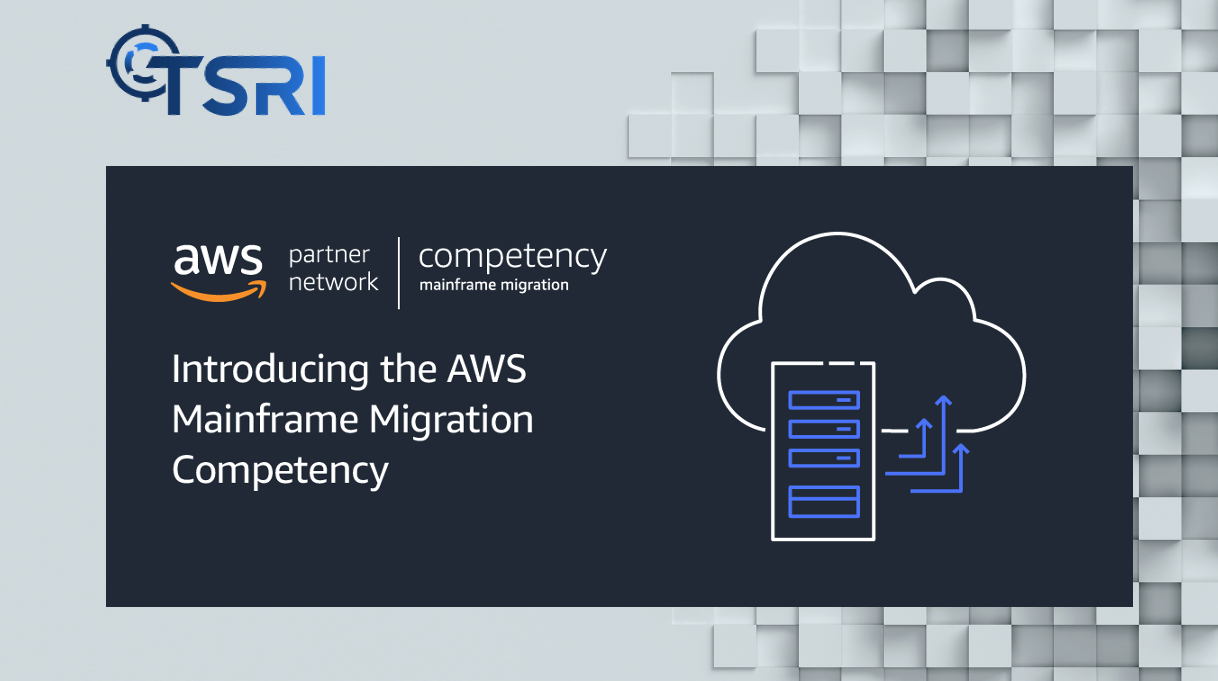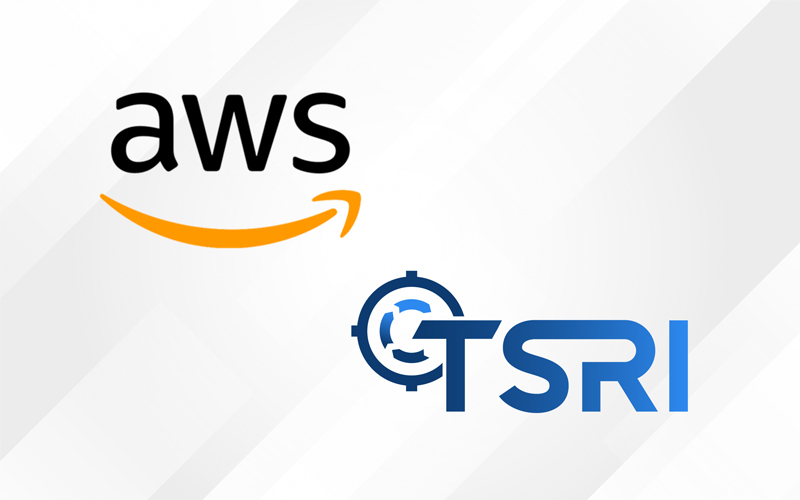Displaying items by tag: aws
AWS Features TSRI as a Validated Partner for Mainframe Migration

When companies and governments need to migrate their mission-critical applications to the cloud, they will need a partner to make that transformation as smooth and efficient as possible. And when it comes to modernization, a highly automated process will get them cloud-ready quickly and accurately. TSRI is here to help organizations begin their modernization journey, and we are honored to be named as a Validated Partner in Amazon Web Services’ new Mainframe Migration Competency!
The AWS Competency Program is designed to identify, validate, and promote AWS Partners with demonstrated technical expertise and proven customer success.
The Competency designation helps AWS Partners differentiate their business to customers by showcasing their products and services in specialized areas across industries, use cases, and workloads. AWS Partners are vetted, validated, and verified against a high bar to achieve the AWS Competency designation.
TSRI joins an elite group of integrators and technical specialists in this competency. With more than 25 years of experience and leadership in modernization across multiple platforms and languages, we are perfectly positioned to help organizations with legacy architectures migrate to the cutting edge.
-----
TSRI is Here for You
As a leading provider of software modernization services, TSRI enables technology readiness for the cloud and other modern architecture environments. We bring software applications into the future quickly, accurately, and efficiently with low risk and minimal business disruption, accomplishing in months what would otherwise take years.
Get started on your modernization journey today!
AWS Names TSRI as a Launch Partner for Mainframe Migration
At AWS re:Invent 2020, Amazon Web Services (AWS) unveiled plans for a new “Mainframe Migration Competency” and announced that TSRI has been identified as a launch partner! AWS recognized that TSRI’s solution — which provides near-100% automation and cloud-specific refactoring — are a huge benefit for organizations seeking reliable, low-risk, and rapid migration to the cloud. Furthermore, TSRI’s proven track record, which includes hundreds of successful modernization projects over more than 25 years, meant that TSRI would be a reliable and knowledgeable technology partner for AWS customers.
 From AWS:
From AWS:
“Recognizing the complexity of a mainframe migration, our customers seek proven methodologies, tools, and best practices to empower successful migrations. The AWS Partner Network (APN) plays a critical role in these efforts by providing proven technology products and services for customers’ mainframe migrations.”
TSRI’s model-based solution transforms even very large (tens of millions of lines of code) legacy systems written in languages like COBOL, Fortran, PowerBuilder, Ada, MUMPS, VB6, and more than 30 other languages, into modern applications in cloud-native target architectures. The output is a modern multi-tier application that takes advantage of cloud utilities and scalability.
Now is the time to modernize for the cloud. According to AWS, “more than 70 percent of the Fortune 500 companies still run business-critical applications on mainframes, and many companies and institutions still possess legacy mainframes in their data centers. As a result of constantly evolving customer needs, the demand for modernization has accelerated as companies require increased agility to meet those needs.
“Due to the slow development cycle of mainframes, more companies are migrating to the cloud to enable rapid development and innovation. Furthermore, as mainframe subject matter experts retire and leave the workforce, these companies face an increasing skills gap.
“Coupled with high upgrade and development costs and expensive usage fees, CIOs with mainframes they must maintain are well aware of the business risks to their enterprise. As a result, a growing number of companies are looking to modernize and migrate their mainframe workloads to Amazon Web Services. These migrations enable companies to realize business benefits like an average 70 percent savings in IT infrastructure costs.”
See the AWS blog for more.
We’re excited to start the modernization journey with any organization looking to get off their mainframe and on to AWS! Learn more about how TSRI can help you transform your technology quickly and seamlessly, ensuring you and your application users can make the most of what cloud technologies have to offer.
-------
TSRI is Here for You
As a leading provider of software modernization services, TSRI enables technology readiness for the cloud and other modern architecture environments. We bring software applications into the future quickly, accurately, and efficiently with low risk and minimal business disruption, accomplishing in months what would otherwise take years.
Get started on your modernization journey today!
Cloud Migration and Containerization: 3 Steps to Reduce Risk and Ensure Success
Nearly everyone wants speed, efficiency, and accuracy—especially when it comes to software applications. As companies modernize their legacy codebases and migrate to the cloud, one of the best ways to achieve top performance is to create containers for modernized code.
 Code modernization has become increasingly important as we move toward integrated cloud-based and virtualized software environments. While the original legacy code was written to meet the needs of the business at that moment time, modernization of code permits these legacy applications to meet the needs of today’s organization while retaining the integrity of the original business logic. Software developers can then focus on innovation rather than maintenance. Modernization makes it possible to meet the demands of today's infrastructure requirements without high cost or compromises in security or functionality. Companies looking to expand services, access improved processes, and use resources more efficiently will need architectural changes. Bringing these trends together, containerization under Docker and Kubernetes has created a new model for application deployment that provides numerous advantages to program operation and interoperability but requires special accommodation.
Code modernization has become increasingly important as we move toward integrated cloud-based and virtualized software environments. While the original legacy code was written to meet the needs of the business at that moment time, modernization of code permits these legacy applications to meet the needs of today’s organization while retaining the integrity of the original business logic. Software developers can then focus on innovation rather than maintenance. Modernization makes it possible to meet the demands of today's infrastructure requirements without high cost or compromises in security or functionality. Companies looking to expand services, access improved processes, and use resources more efficiently will need architectural changes. Bringing these trends together, containerization under Docker and Kubernetes has created a new model for application deployment that provides numerous advantages to program operation and interoperability but requires special accommodation.
Containers provide consolidation benefits by permitting application instances to be stacked in larger virtual machines. Containerization improves efficiency, security, and reduces software licensing. It reduces complexity and ensures application portability, but the boost to protecting an organization’s systems at a time when only 56% of companies are integrating security into their technology strategies cannot be understated, according to Advanced’s 2020 Digital Business Report.
To take advantage of not just the security inherent to containerization, but the potential of having systems that can be ready for the next big advances in computing, applications must be modernized to externalize APIs and microservices. It is also important to ensure proper function within a containerized environment. Modernization transforms legacy applications to operate efficiently, reliably, and securely within the new environment with identical performance to the original application.
The Three-Step Approach: Transform, Cloud-Enable, Containerize & Deploy
When thinking about modernization, organizations can take a three-step approach based on TSRI’s experience in all forms of legacy code transformation, including migration to cloud services and containerization, to reduce risk and increase success:
1. Migrate legacy monolithic code to a service-oriented environment. This includes updating language from COBOL to Java, JavaScript, or C#, changing databases, and enabling microservices. At this step of the process, the migration also begins to abstract underlying services from the application.
2. Integrate service-oriented applications with native cloud services. This includes re-orienting code from WebSphere, DB2, or other legacy platforms to Apache Tomcat, Amazon RDS, or other modern platforms, for example. Upgrading to incorporate the latest native architectural interfaces ensures that applications will tightly integrate with the new environment, and ensures easier updates in future.
3. Transform native cloud to Docker containers. The movement to containers provides additional architectural abstraction and improved integration of applications within the cloud.
As with any kind of migration and modernization, organizations need to assess, tune and optimize their applications for suitability and to ensure that applications will perform adequately within the container environment without infrastructure issues that might arise from coding anomalies.
The key to a successful migration is to evaluate and model the underlying legacy code logic and to pinpoint the areas that require adaptation to the new environment. Not every application has a natural and hazard-free path to a cloud-based containerized solution. Knowledge of container operations such as ephemeral storage and parallelization issues is extremely important in managing this transition. The transformed code must also be optimized to meet the needs of its new environment.
In the case of migrating and modernizing mainframe systems to the cloud, fully automated refactoring technologies such as TSRI’s JANUS Studio® toolset transform legacy applications to cloud-native applications for containerized deployment on multiple cloud providers, including a practice devoted specifically to AWS. TSRI’s model-based solution transforms even large legacy systems written in languages such as COBOL, Fortran, PowerBuilder, Ada, MUMPS, and VB6 into modern applications in cloud-native target architectures.
-------
TSRI is Here for You
As a leading provider of software modernization services, TSRI enables technology readiness for the cloud and other modern architecture environments. We bring software applications into the future quickly, accurately, and efficiently with low risk and minimal business disruption, accomplishing in months what would otherwise take years.
Get started on your modernization journey today!
AWS Blog Featured Post: Automated Refactoring of a U.S. Department of Defense Mainframe to AWS
United States Air Force SBSS ILS-S COBOL to Java on AWS Modernization
A major component of the system is 54 years old, written in COBOL, and provides retail-level business logic. The component runs on mainframes that have proven to be extremely difficult to change and manage, and the DoD needed to modernize the component to drive down operating costs and move to an open platform, while retaining all functionality....

